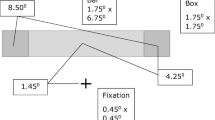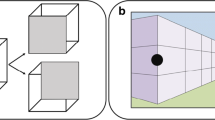Abstract
Pictorial illusions bias our judgments about certain visual attributes. Such illusions are therefore only expected to influence a task if these attributes are used to perform the task. When pointing to a position, different visual attributes could be used to guide the hand: direction and distance (or length) of the required displacement (vector coding) or the final position (position coding). In this study we used the Brentano illusion (an illusion of length) to determine which attributes are used in pointing. Several conditions were tested in which the visibility of the hand and the stimulus were varied. The illusion influenced movements between two points along the shaft of the figure, but not movements perpendicular to the shaft. When the hand and/or target were invisible during the movement, the influence of the illusion increased. Pointing movements under different visual conditions were based on different relative contributions of position and vector coding. The contribution of vector coding was always rather modest.







Similar content being viewed by others
Notes
When the image was realigned in the hand visible and target invisible condition, the coordinate system for determining the positions was redefined so that positions are always in relation to the figure on the screen.
References
Abrams RA, Meyer DE, Kornblum S (1990) Eye-hand coordination: oculomotor control in rapid aimed limb movements. J Exp Psychol Hum Percept Perform 16:248–267
Bizzi E, Hogan N, Mussa-Ivaldi FA, Giszter S (1992) Does the nervous system use equilibrium point control to guide single and multiple joint movements? Behav Brain Sci 15:603–613
Bock O, Eckmiller R (1986) Goal-directed arm movements in absence of visual guidance: evidence for amplitude rather than position control. Exp Brain Res 62:451–458
Carrazzo M, McIntyre J, Zago M, Lacquaniti F (1999) Viewer-centered and body centered frames of reference in direct visuomotor transformations. Exp Brain Res 129:201–210
de Grave DDJ, Brenner E, Smeets JBJ (2002) Are the original Roelofs effect and the induced Roelofs effect caused by the same shift in straight ahead? Vis Res 42:2279–2285
Desmurget M, Pélisson D, Rossetti Y, Prablanc C (1998) From eye to hand: planning goal-directed movements. Neurosci Biobehav Rev 22:761–788
Feldman AG, Levin MF (1995) The origin and use of positional frames of reference in motor control. Behav Brain Sci 18:723–806
Gentilucci M, Chieffi S, Daprati E, Saetti MC, Toni I (1996) Visual illusion and action. Neuropsychologia 34:369–376
Gillam B (1998) Illusions at century’s end. In: Hochberg J (ed) Perception and cognition at century’s end. Academic Press, London, pp 95–136
Gillam B, Chambers D (1985) Size and position are incongruous: measurements on the Müller-Lyer figure. Percept Psychophys 37:549–556
Glover S, Dixon P (2001) Dynamic illusion effects in a reaching task: evidence for separate visual representations in the planning and control of reaching. J Exp Psychol Hum Percept Perform 27:560–572
Glover S, Dixon P (2002) Dynamic effects of the Ebbinghaus illusion in grasping: support for a planning/control model of action. Percept Psychophys 64:266–278
Mack A, Heuer F, Villardi K, Chambers D (1985) The dissociation of position and extent in Muller-Lyer figures. Percept Psychophys 37:335–344
McIntyre J, Stratta F, Lacquaniti F (1997) Viewer-centered frame of reference for pointing to memorized targets in three-dimensional space. J Neurophysiol 78:1601–1618
McIntyre J, Stratta F, Lacquaniti F (1998) Short-term memory for reaching to visual targets: Psychophysical evidence for body-centered reference frames. J Neurosci 18:8423–8435
Messier J, Kalaska JF (1997) Differential effect of task condition on errors of direction and extent of reaching movements. Exp Brain Res 115:469–478
Post RB, Welch RB (1996) Is there dissociation of perceptual and motor responses to figural illusions? Perception 25:569–581
Prablanc C, Martin O (1992) Automatic control during hand reaching at undetected two dimensional target displacements. J Neurophysiol 67:455–469
Rossetti Y, Desmurget M, Prablanc C (1995) Vectorial coding of movement: vision, kinaesthesia, or both? J Neurophysiol 74:457–463
Smeets JBJ, Brenner E, de Grave DDJ, Cuijpers RH (2002) Illusions in action: consequences of inconsistent processing of spatial attributes. Exp Brain Res 147:135–144
Van den Dobbelsteen JJ, Brenner E, Smeets JBJ (2001) Endpoints of arm movements to visual targets. Exp Brain Res 138:279–287
Vindras P, Viviani P (1998) Frames of reference and control parameters in visuomanual pointing. J Exp Psychol Hum Percept Perform 24:569–591
Author information
Authors and Affiliations
Corresponding author
Rights and permissions
About this article
Cite this article
de Grave, D.D.J., Brenner, E. & Smeets, J.B.J. Illusions as a tool to study the coding of pointing movements. Exp Brain Res 155, 56–62 (2004). https://doi.org/10.1007/s00221-003-1708-x
Received:
Accepted:
Published:
Issue Date:
DOI: https://doi.org/10.1007/s00221-003-1708-x




